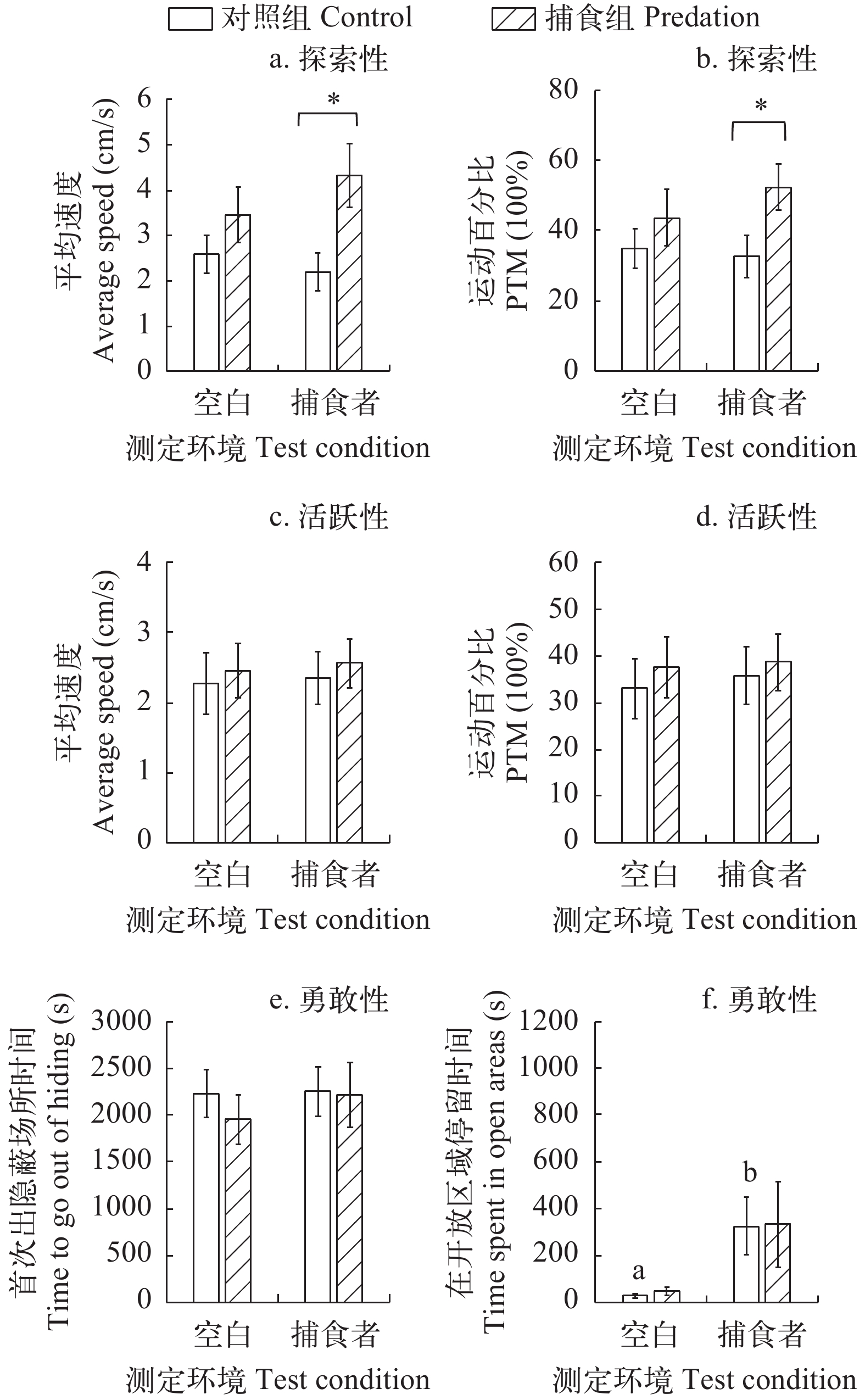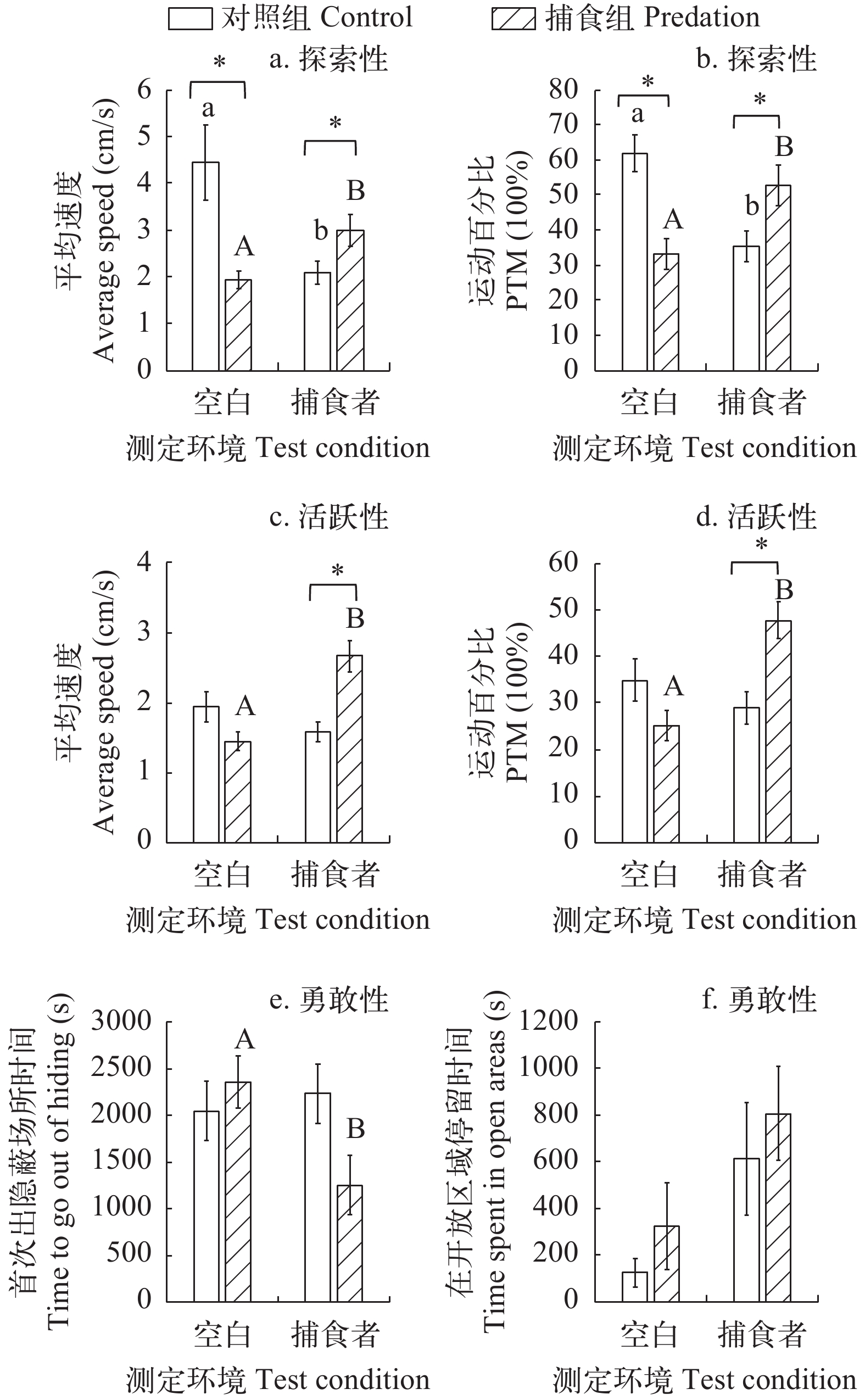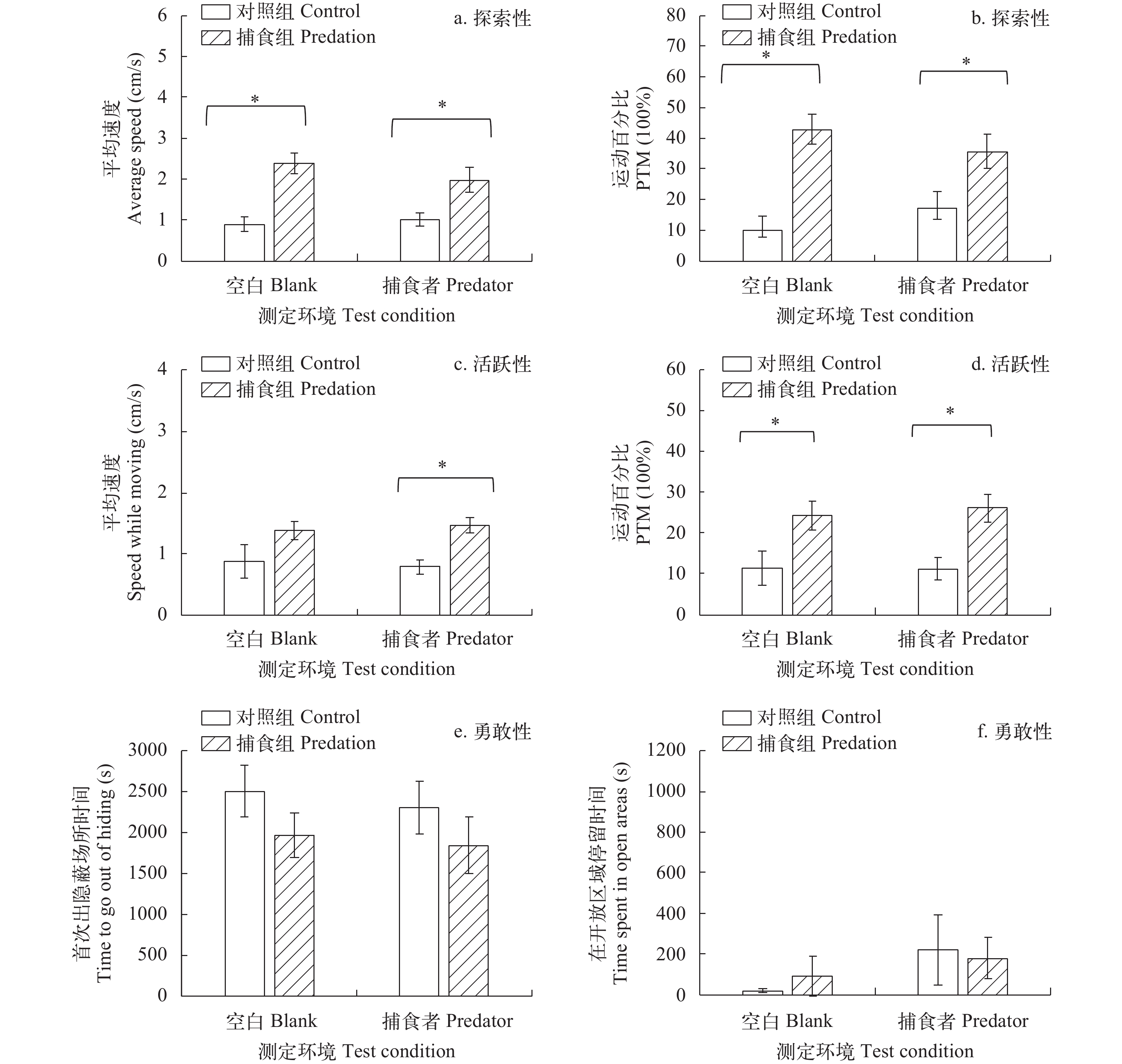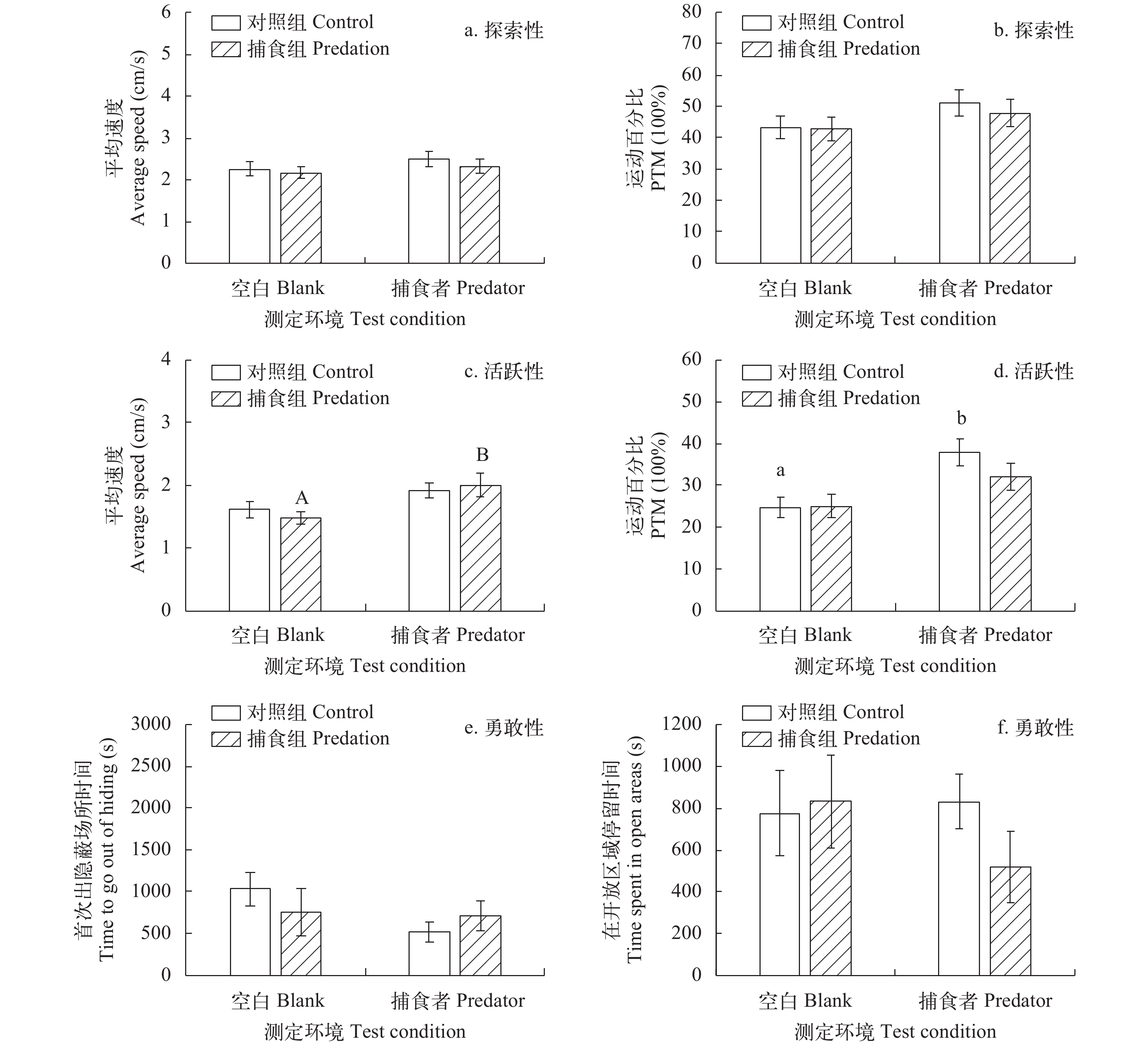INTERSPECIFIC COMPARISON OF THE BEHAVIORAL RESPONSES TO PREDATION STRESS IN FOUR CYPRINIDS
-
摘要: 为了比较早期捕食胁迫经历和当前环境中存在的捕食者对鱼类行为的影响, 并考查这些影响是否存在种间差异, 研究分别考查了测定环境(有、无捕食者存在)对有、无捕食胁迫经历的鳊(Parabramis pekinensis)、草鱼(Ctenopharyngodon idellus)、鲫(Carassius auratus)和中华倒刺鲃(Spinibarbus sinensis)等4种鲤科鱼类探索性、活跃性和勇敢性的影响。结果发现: 早期捕食胁迫经历与当前环境条件对鱼类行为产生截然不同的影响, 且存在较大的种间差异。无捕食胁迫经历的鳊、草鱼和中华倒刺鲃均会对陌生的捕食者乌鳢(Channa argus)做出行为响应, 提示这3种鱼可能对陌生捕食者具有一定的识别能力, 但这种识别与猎物鱼通过捕食胁迫经历获得的识别仍具有一定差距; 具有捕食胁迫经历的鳊和中华倒刺鲃在空白环境中未表现出反捕食行为, 可能是节约能量的一种策略。总体而言, 草鱼对捕食胁迫经历和测定环境处理反应更为敏感, 而中华倒刺鲃的反应则相对保守。但当周围环境中存在捕食者时, 4种鲤科鱼类均会通过维持较高运动状态的方式来应对捕食者。维持这种应激状态可能对猎物鱼保持与捕食者的距离, 并随时保持警惕较为关键。Abstract: In nature, fish often suffer from various of predation stress. Thus, prey fish often respond to their predators by adjusting their behavior, which is called anti-predator behavior. Investigating the correlations between behavioral characteristics of fishes and their physiological functions and habitat environment at the interspecific level is helpful to understand the internal mechanism of interspecific differentiation of behavioral strategies of fishes, therefore ecologically important. The previous predation stress experience and the presence of predators in the current environment may act different effects on the behavior of prey fish, because the prey fish need to maximize survival and minimize the cost of anti-predator behavior. The aims of this study were to compare the effects of previous predation stress experience and the presence of predators in the current environment on the behavior of prey fish, and to examine whether there are interspecific differences for these effects. In this study, the effects of both previous predation stress experience and present predation stress on exploration, activity and boldness in juvenile bream (Parabramis pekinensis), grass carp (Ctenopharyngodon idellus), crucian carp (Carassius auratus) and qingbo (Spinibarbus sinensis) were investigated. The results showed that, the effects of predation stress experienced early on the behavior of fish are quite different from those of predators in the current environment, and these effects are also quite different among the four species. The naïve bream, grass carp and qingbo performed anti-predator behavior to the strange predator snakehead fish (Channa argus), which suggested that these three fish could recognize the strange predator snakehead fish, but such a recognition is still different from the recognition obtained from real predation experience. The bream and qingbo with predation stress experience did not exhibited anti-predator behavior in blank environment, which may be a strategy for conserving energy. In general, grass carps were more sensitive to predation stress and environmental treatment, while the response of qingbo was more conservative. The differences in anti-predator responses among the four cyprinids may be closely related to the physiological phenotypes of the four cyprinids, such as morphology and swimming performance, and the predation pressure in the habitat environment. In terms of similarities, all the four species respond to predators by maintaining high levels of swimming in the presence of predators. Maintaining this stress state may be critical to keeping the prey fish stay away from the predator and staying alert at all times.
-
Keywords:
- Predation stress /
- Anti-predator behavior /
- Cyprinids /
- Interspecies difference /
- Identification
-
-
图 2 捕食胁迫经历和测定环境对鳊幼鱼探索性、活跃性和勇敢性的影响
不同的小写字母(a, b)代表对照组的实验鱼在不同测定环境下相关参数差异显著(P<0.05); 不同的大写字母(A, B)代表捕食组实验鱼在不同测定环境下相关参数差异显著(P<0.05); *表示在空白或捕食者存在环境下, 对照组与捕食者的相关参数差异显著(P<0.05); 下同
Figure 2. Effects of predation experience and measuring environment on exploration, activity and boldness in juvenile bream
Different lowercase letters (a, b) represent the significant differences between different measuring environment of the fish in the control group (P<0.05). The different uppercase letters (A, B) represent the significant differences between different measuring environment of the fish in the predation group (P<0.05). * indicates the significant differences between control and predation groups in either blank or predator present environment (P<0.05), the same applies below
表 1 不同组实验鱼的体重、体长和样本量(平均值±SE)
Table 1 The body weight, body length and sample size of different groups (mean±SE)
种类
Species前期处理
Preprocessing测定环境
Test conditions样本量
Sample size体重
Body mass (g)体长
Body length (cm)鳊
Parabramis pekinensis对照 空白 n=20 2.49±0.12 5.40±0.10 捕食者 n=20 2.78±0.16 5.60±0.09 捕食经历 空白 n=20 2.22±0.16 5.15±0.10 捕食者 n=20 2.34±0.19 5.18±0.13 草鱼
Ctenopharyngodon idellus对照 空白 n=20 2.98±0.12 5.64±0.09 捕食者 n=20 3.45±0.28 5.84±0.17 捕食经历 空白 n=20 3.31±0.23 5.67±0.12 捕食者 n=20 3.15±0.21 5.63±0.12 鲫
Carassius auratus对照 空白 n=20 3.02±0.16 5.03±0.09 捕食者 n=20 3.19±0.16 5.17±0.09 捕食经历 空白 n=20 3.30±0.27 5.17±0.15 捕食者 n=20 3.06±0.19 5.16±0.11 中华倒刺鲃
Spinibarbus sinensis对照 空白 n=20 4.24±0.24 6.12±0.11 捕食者 n=20 4.19±0.30 6.06±0.15 捕食经历 空白 n=20 3.95±0.22 5.97±0.10 捕食者 n=20 4.36±0.30 6.16±0.13 表 2 捕食胁迫经历和测定环境对鳊幼鱼探索性、活跃性和勇敢性的影响
Table 2 Effects of predation experience and measuring environment on exploration, activity and boldness in juvenile bream
行为
Behavior指标
Index协变量(体重)
Covariate (Body mass)前期处理
Preprocessing测定环境
Test condition交互作用
Interaction探索性
Exploration平均速度(cm/s) F1.73=0.010
P=0.920F1.73=7.026
P=0.010F1.73=0.170
P=0.681F1.73=1.131
P=0.256运动百分比(%) F1.73=0.252
P=0.618F1.73=4.912
P=0.030F1.73=0.170
P=0.682F1.73=0.715
P=0.400活跃性
Activity平均速度(cm/s) F1.75=0.003
P=0.959F1.75=0.228
P=0.634F1.75=0.058
P=0.811F1.75=0.001
P=0.980运动百分比(%) F1.75=0.069
P=0.794F1.75=0.268
P=0.606F1.75=0.108
P=0.744F1.75=0.025
P=0.874勇敢性
Boldness首次出隐蔽场所时间(s) F1.75=0.198
P=0.657F1.75=0.433
P=0.513F1.75=0.294
P=0.589F1.75=0.148
P=0.702在开放区域停留时间(s) F1.75=0.034
P=0.854F1.75=0.035
P=0.852F1.75=6.532
P=0.013F1.75=0.002
P=0.946表 3 捕食胁迫经历和测定环境对草鱼幼鱼探索性、活跃性和勇敢性的影响
Table 3 Effects of predation experience and measuring environment on exploration, activity and boldness in juvenile grass carp
行为
Behavior指标
Index协变量(体重)
Covariate (Body mass)前期处理
Preprocessing测定环境
Test condition交互作用
Interaction探索性
Exploration平均速度(cm/s) F1.75=0.640
P=0.426F1.75=2.905
P=0.092F1.75=1.714
P=0.194F1.75=11.958
P=0.001运动百分比(%) F1.75=0.922
P=0.340F1.75=1.255
P=0.266F1.75=0.378
P=0.541F1.75=18.784
P=0.000活跃性
Activity平均速度(cm/s) F1.75=1.089
P=0.300F1.75=2.676
P=0.106F1.75=5.932
P=0.017F1.75=16.393
P=0.000运动百分比(%) F1.75=1.814
P=0.182F1.75=1.440
P=0.234F1.75=5.183
P=0.026F1.75=12.086
P=0.001勇敢性
Boldness首次出隐蔽场所时间(s) F1.74=0.740
P=0.392F1.74=1.086
P=0.301F1.74=1.920
P=0.170F1.74=4.727
P=0.033在开放区域停留时间(s) F1.74=2.263
P=0.137F1.74=1.083
P=0.301F1.74=6.297
P=0.014F1.74=0.046
P=0.831表 4 捕食胁迫经历和测定环境对鲫幼鱼探索性、活跃性和勇敢性的影响
Table 4 Effects of predation experience and measuring environment on exploration, activity and boldness in juvenile crucian carp
行为
Behavior指标
Index协变量(体重)
Covariate (Body mass)前期处理
Preprocessing测定环境
Test condition交互作用
Interaction探索性
Exploration平均速度(cm/s) F1.73=7.742
P=0.007F1.73=31.595
P<0.001F1.73=0.357
P=0.552F1.73=0.782
P=0.379运动百分比(%) F1.73=7.883
P=0.006F1.73=39.331
P<0.001F1.73=0.003
P=0.958F1.73=2.055
P=0.156活跃性
Activity平均速度(cm/s) F1.74=0.190
P=0.664F1.74=10.574
P=0.002F1.74=0.000
P=1.000F1.74=0.268
P=0.607运动百分比(%) F1.74=0.086
P=0.770F1.74=15.440
P<0.001F1.74=0.050
P=0.823F1.74=0.110
P=0.741勇敢性
Boldness首次出隐蔽场所时间(s) F1.75=1.073
P=0.304F1.75=2.378
P=0.127F1.75=0.269
P=0.606F1.75=0.000
P=0.987在开放区域停留时间(s) F1.75=2.842
P=0.096F1.75=0.011
P=0.196F1.75=2.445
P=0.122F1.75=0.146
P=0.704表 5 捕食胁迫经历和测定环境对中华倒刺鲃幼鱼探索性、活跃性和勇敢性的影响
Table 5 Effects of predation experience and measuring environment on exploration, activity and boldness in juvenile qingbo
行为
Behavior指标
Index协变量(体重)
Covariate (Body mass)前期处理
Preprocessing测定环境
Test condition交互作用
Interaction探索性
Exploration平均速度(cm/s) F1.74=4.914
P=0.030F1.74=0.709
P=0.402F1.74=0.929
P=0.338F1.74=0.272
P=0.604运动百分比(%) F1.74=7.758
P=0.007F1.74=0.261
P=0.611F1.74=2.076
P=0.154F1.74=0.506
P=0.479活跃性
Activity平均速度(cm/s) F1.74=0.340
P=0.562F1.74=0.017
P=0.897F1.74=8.218
P=0.005F1.74=0.428
P=0.515运动百分比(%) F1.74=1.273
P=0.263F1.74=0.851
P=0.359F1.74=11.189
P=0.001F1.74=1.311
P=0.256勇敢性
Boldness首次出隐蔽场所时间(s) F1.75=0.926
P=0.339F1.75=0.045
P=0.833F1.75=1.655
P=0.202F1.75=1.468
P=0.229在开放区域停留时间(s) F1.75=0.296
P=0.588F1.75=0.441
P=0.508F1.75=0.544
P=0.463F1.75=1.069
P=0.305 -
[1] Creel S, Christianson D. Relationships between direct predation and risk effects [J]. Trends in Ecology & Evolution, 2008, 23(4): 194-201.
[2] Fürtbauer I, Pond A, Heistermann M, et al. Personality, plasticity and predation: linking endocrine and behavioural reaction norms in stickleback fish [J]. Functional Ecology, 2015, 29(7): 931-940. doi: 10.1111/1365-2435.12400
[3] Ingley S J, Billman E J, Belk M C, et al. Morphological divergence driven by predation environment within and between species of Brachyrhaphis fishes [J]. PLoS One, 2014, 9(2): e90274. doi: 10.1371/journal.pone.0090274
[4] Lönnstedt O M, McCormick M I, Meekan M G, et al. Learn and live: predator experience and feeding history determines prey behaviour and survival [J]. Proceedings of the Royal Society B, 2012, 279(1736): 2091-2098. doi: 10.1098/rspb.2011.2516
[5] Domenici P, Turesson H, Brodersen J, et al. Predator-induced morphology enhances escape locomotion in crucian carp [J]. Proceedings of the Royal Society B, 2008, 275(1631): 195-201. doi: 10.1098/rspb.2007.1088
[6] Archard G A, Earley R L, Hanninen A F, et al. Correlated behaviour and stress physiology in fish exposed to different levels of predation pressure [J]. Functional Ecology, 2012, 26(3): 637-645. doi: 10.1111/j.1365-2435.2012.01968.x
[7] Alvarez D, Nicieza A G. Predator avoidance behaviour in wild and hatchery-reared brown trout: the role of experience and domestication [J]. Journal of Fish Biology, 2003, 63(6): 1565-1577. doi: 10.1111/j.1095-8649.2003.00267.x
[8] Fu C, Fu S J, Cao Z D, et al. Habitat-specific anti-predator behavior variation among pale chub (Zacco platypus) along a river [J]. Marine and Freshwater Behaviour and Physiology, 2015, 48(4): 267-278. doi: 10.1080/10236244.2015.1050785
[9] 夏继刚, 刘香, 黄艳. 高体鳑鲏化学预警响应与“个性”行为的关联 [J]. 生态学报, 2019, 39(17): 6425-6432. Xia J G, Liu X, Huang Y. The link between chemical alarm cue-induced behavioral responses and personality in Rhodeus ocellatus [J]. Acta Ecologica Sinica, 2019, 39(17): 6425-6432.
[10] 张嫱, 付世建, 夏继刚. 鱼类“个性”行为及其研究进展 [J]. 生态学杂志, 2017, 36(12): 3623-2628. Zhang Q, Fu S J, Xia J G. Recent progress on the personality of fish [J]. Chinese Journal of Ecology, 2017, 36(12): 3623-2628.
[11] Reid D, Armstrong J D, Metcalfe N B. The performance advantage of a high resting metabolic rate in juvenile salmon is habitat dependent [J]. Journal of Animal Ecology, 2012, 81(4): 868-875. doi: 10.1111/j.1365-2656.2012.01969.x
[12] Meerhoff M, Iglesias C, De Mello F T, et al. Effects of habitat complexity on community structure and predator avoidance behaviour of littoral zooplankton in temperate versus subtropical shallow lakes [J]. Freshwater Biology, 2007, 52(6): 1009-1021. doi: 10.1111/j.1365-2427.2007.01748.x
[13] Xu J J, Fu S J, Fu C. Physiological and behavioral stress responses to predators are altered by prior predator experience in juvenile qingbo (Spinibarbus sinensis) [J]. Biology Open, 2019, 8(5): bio041012.
[14] Wang Y, Fu S J, Fu C. Behavioral adjustments to prior predation experience and food deprivation of a common cyprinid fish species vary between singletons and a group [J]. Peer J, 2019(7): e7236.
[15] Millidine K J, Armstrong J D, Metcalfe N B. Presence of shelter reduces maintenance metabolism of juvenile salmon [J]. Functional Ecology, 2006, 20(5): 839-845. doi: 10.1111/j.1365-2435.2006.01166.x
[16] Liu H S, Zeng L Q, Cao Z D, et al. Effects of different predator stress on vulnerability to predation and the underlying physiological and behavioral mechanisms of this vulnerability in juvenile qingbo (Spinibarbus sinensis) [J]. Acta Ecologica Sinica, 2016, 36(2): 85-90. doi: 10.1016/j.chnaes.2016.01.005
[17] Tang J Y, Fu S J. The relationship between personality and the collective motion of schooling fish [J]. Journal of Ethology, 2020, 38(3): 333-341. doi: 10.1007/s10164-020-00655-1
[18] Tang Z H, Huang Q, Wu H, et al. The behavioral response of prey fish to predators: the role of predator size [J]. Peer J, 2017(5): e3222.
[19] Biro P A, Abrahams M V, Post J R, et al. Predators select against high growth rates and risk-taking behaviour in domestic trout populations [J]. Proceedings of the Royal Society B, 2004, 271(1554): 2233-2237. doi: 10.1098/rspb.2004.2861
[20] Stoks R, McPeek M A, Mitchell J L. Evolution of prey behavior in response to changes in predation regime: damselflies in fish and dragonfly lakes [J]. Evolution, 2003, 57(3): 574-585. doi: 10.1111/j.0014-3820.2003.tb01549.x
[21] Licht T. Discriminating between hungry and satiated predators: the response of guppies (Poecilia reticulata) from high and low predation sites [J]. Ethology, 1989(82): 238-243.
[22] Fu C, Cao Z D, Fu S J. Predation experience underlies the relationship between locomotion capability and survival [J]. Comparative Biochemistry and Physiology A, 2019(227): 32-38.
[23] Kelley J L, Magurran A E. Learned predator recognition and antipredator responses in fishes [J]. Fish and Fisheries, 2003(4): 216-226.
[24] Fu C, Fu S J, Wu Q Y, et al. Predation threat modifies relationships between metabolism and behavioural traits but not their ecological relevance in Chinese bream [J]. Marine and Freshwater Behaviour and Physiology, 2017, 50(5-6): 329-344. doi: 10.1080/10236244.2017.1411158
[25] Yan G J, He X K, Cao Z D, et al. An interspecific comparison between morphology and swimming performance in cyprinids [J]. Journal of Evolutionary Biology, 2013, 26(8): 1802-1815. doi: 10.1111/jeb.12182
[26] Fu C, Cui Y L, Xu J J, et al. A study on the physiological and behavioral mechanisms underlying the differences in survival capacity between two cyprinid fish species [J]. Comparative Biochemistry and Physiology A, 2019(231): 74-81.
[27] Archard G A, Braithwaite V A. Increased exposure to predators increases both exploration and activity level in Brachyrhaphis episcopi [J]. Journal of Fish Biology, 2011, 78(2): 593-601. doi: 10.1111/j.1095-8649.2010.02880.x
[28] Brown C, Jones F, Braithwaite V. In situ examination of boldness-shyness traits in the tropical poeciliid, Brachyraphis episcopi [J]. Animal Behaviour, 2005, 70(5): 1003-1009. doi: 10.1016/j.anbehav.2004.12.022
[29] Magnhagen C, Borcherding J. Risk-taking behaviour in foraging perch: does predation pressure influence age-specific boldness [J]? Animal Behaviour, 2008, 75(2): 509-517.
[30] 周龙艳, 李秀明, 付世建. 捕食驯化对胭脂鱼和中华倒刺鲃游泳行为、应激和免疫功能的影响[J]. 水生生物学报, 2021, doi: 10.7541/2021.2020.015. Zhou L Y, Li X M, Fu S J. The effects of predation acclimation on swimming behavior, stress and immune responses of juvenile Myxocyprinus asiaticus and Spinibarbus sinensis [J]. Acta Hydrobiologica Sinica, 2021, doi: 10.7541/2021.2020.015.



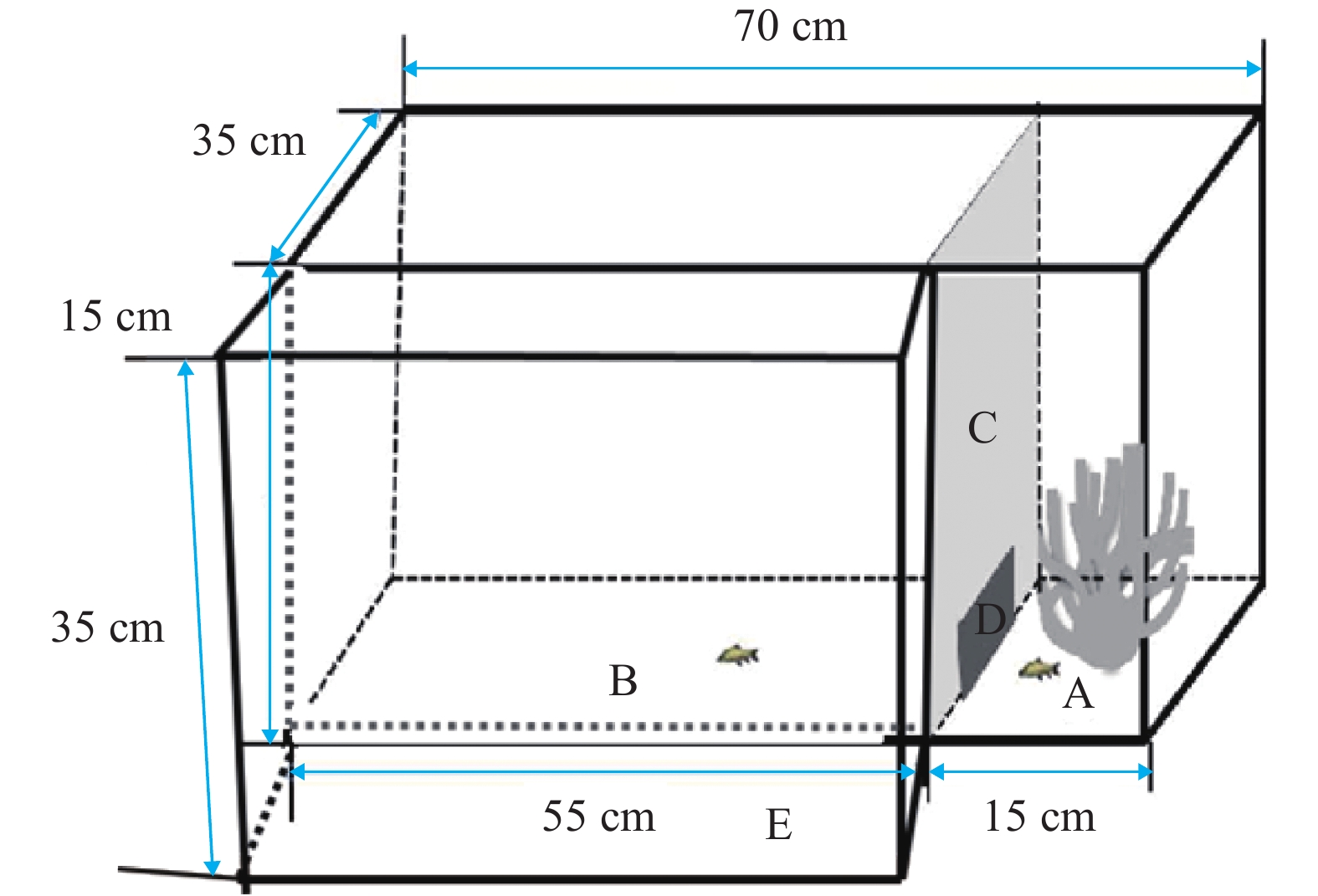
 下载:
下载:
